-

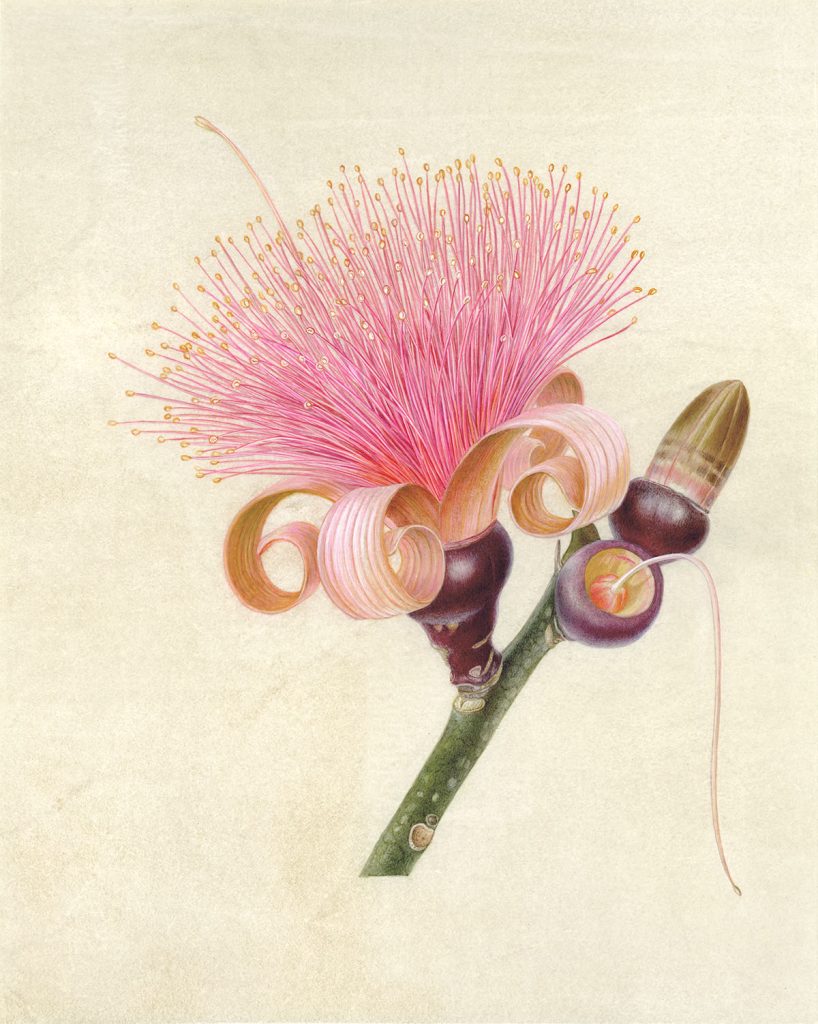
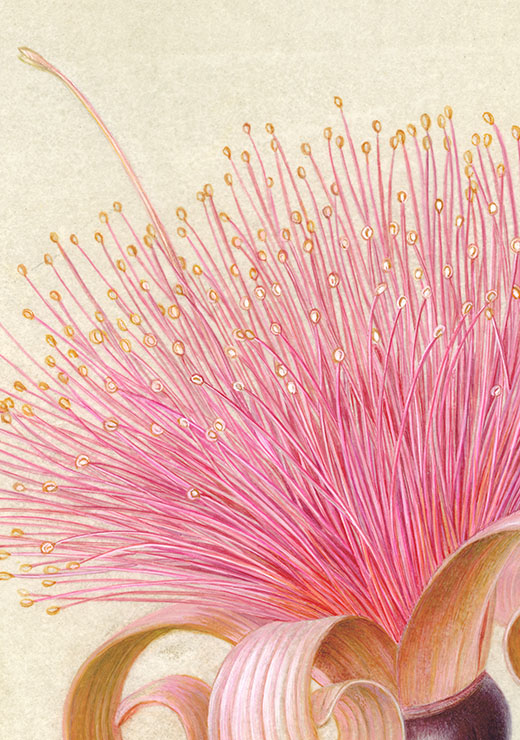
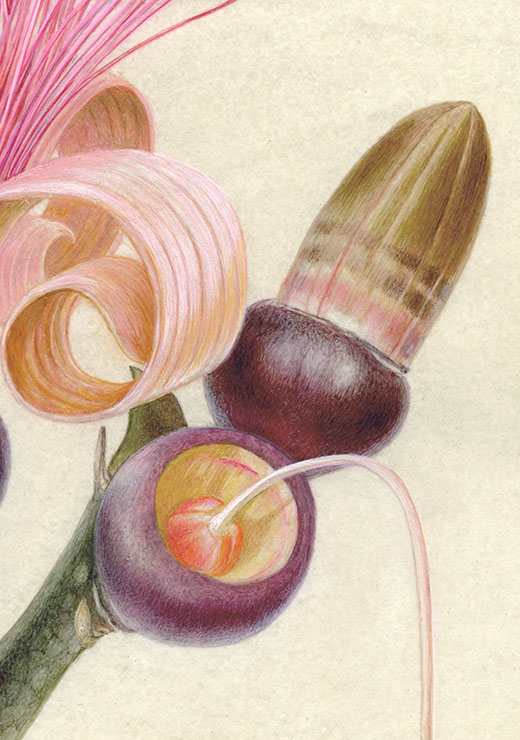
Shaving brush tree
Pseudobombax ellipticumシェービングブラシ・ツリーThe shaving brush tree is native to Central America. Its flowers are characterized by long white or pink stamens that resemble a shaving brush, hence the name. A friend of mine who lives in Hawaii grows this tree in two colors, and I have always wanted to paint its pink flowers. However, the flowers only last a few hours after blooming, making them difficult to paint. Their shape is fascinating and I was able to capture the fine stamens as best as I could.
シェービングブラシ・ツリーは、中央アメリカ原産の落葉高木。花は白とピンクがあり、長い雄蕊が特徴的で、これが髭剃りブラシに似ていることから名付けられた。ハワイの友人宅にあったこの木は、ずっと描いてみたかったのだが、花は開花したら、数時間で萼の部分から落ちてしまうので難しい。その形状は全てが魅力的で、繊細な雄蕊をなんとか描きあげた。
25.0 x 20.0cm Watercolor on vellum ヴェラムに水彩
-
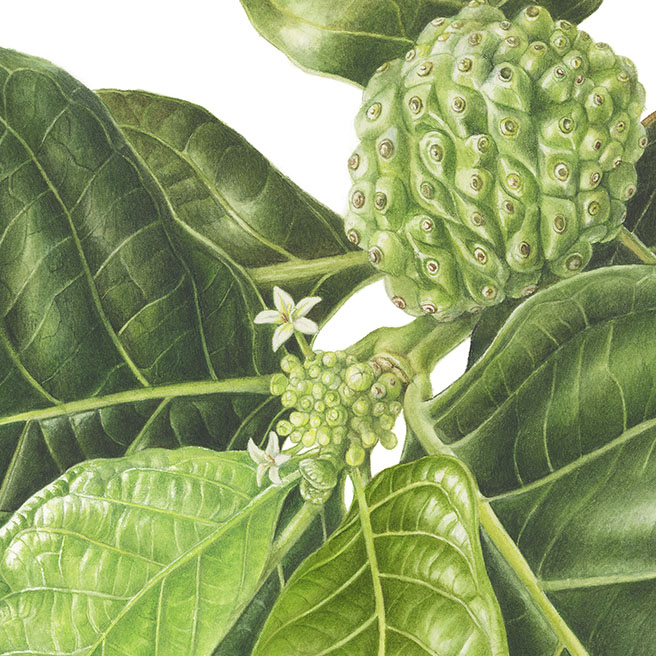
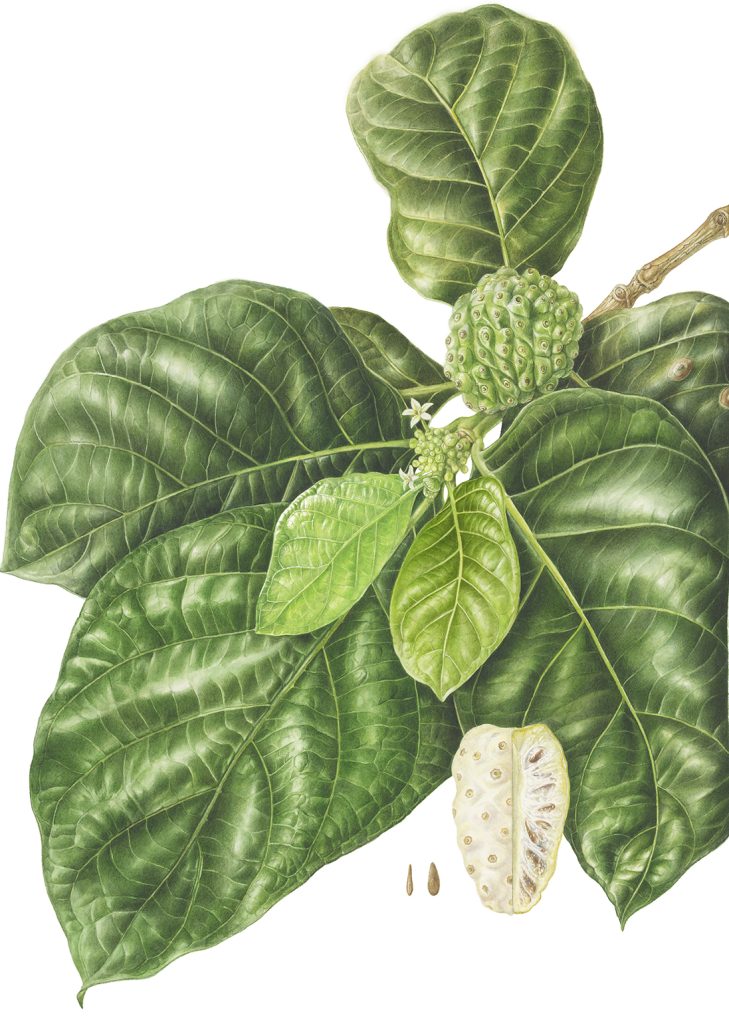
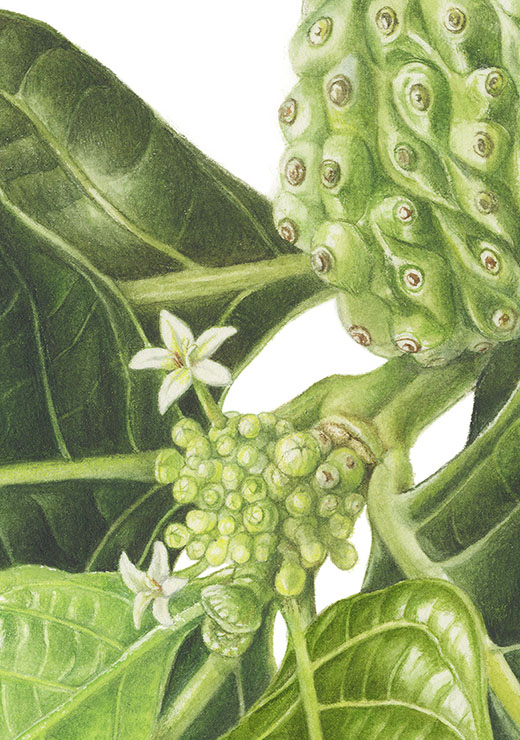
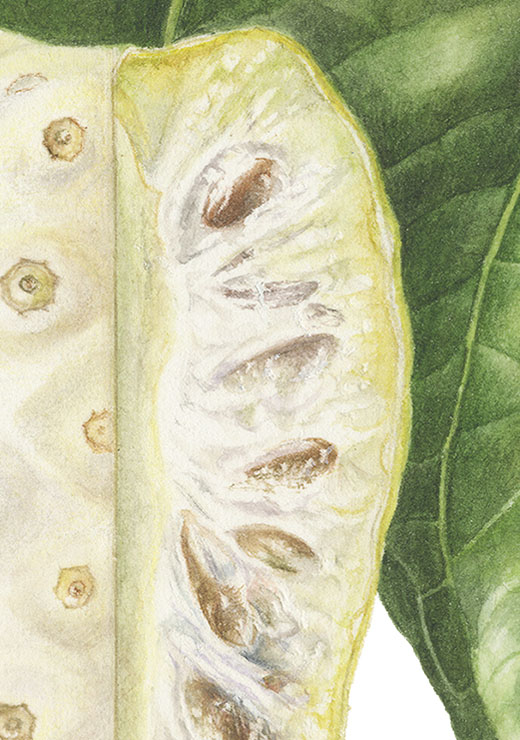
Noni
Morinda citrifoliaノニIn Hawaii, the plants known as "canoe plants" were brought by Polynesians who migrated from the Marquesas and Tahiti between the 6th and 12th centuries. The Polynesians loaded these plants, along with various other essential supplies, onto their canoes. Because these plants have special significance in traditional Hawaiian culture, they are not just foreign plants; they are called "canoe plants." One of these plants is the noni, which has been eaten for its health-maintaining, staminaboosting, and disease-preventing properties. It is still used in many everyday products, such as health supplements, soaps, etc.
ハワイの植物の中で「カヌープランツ」と称されるものは、6世紀から12世紀にかけてマルケサスやタヒチから移り住んだポリネシア人が日常生活に不可欠なさまざまな物資をカヌーに積んで持ちこんだ植物で、ハワイの伝統文化のなかでも特別な意味を持つことから、単なる外来植物ではなく、カヌープランツと呼ばれている。そのうちの一つであるNoniは、ノニは健康維持、スタミナ増進、病気の予防などのために食されてきた。今でも健康補助食品や石鹸など多くの身の回りのものに使用されている。
32 x 45cm Watercolor on paper 紙に水彩
-
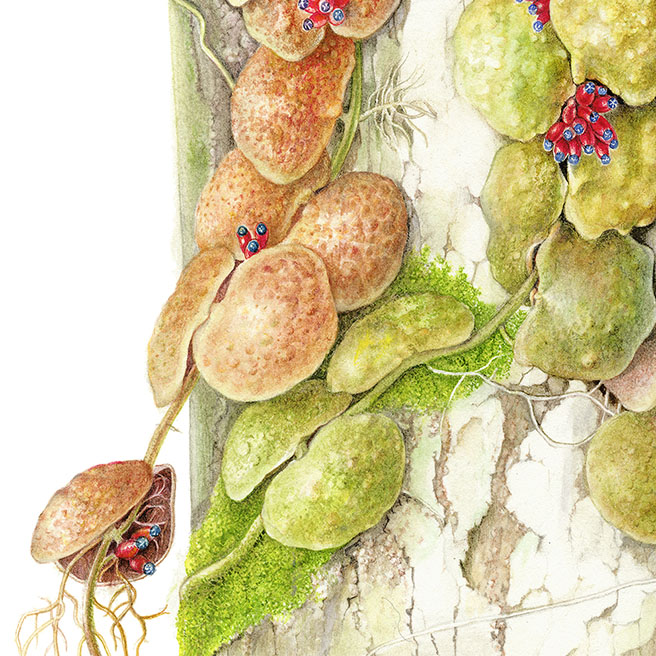
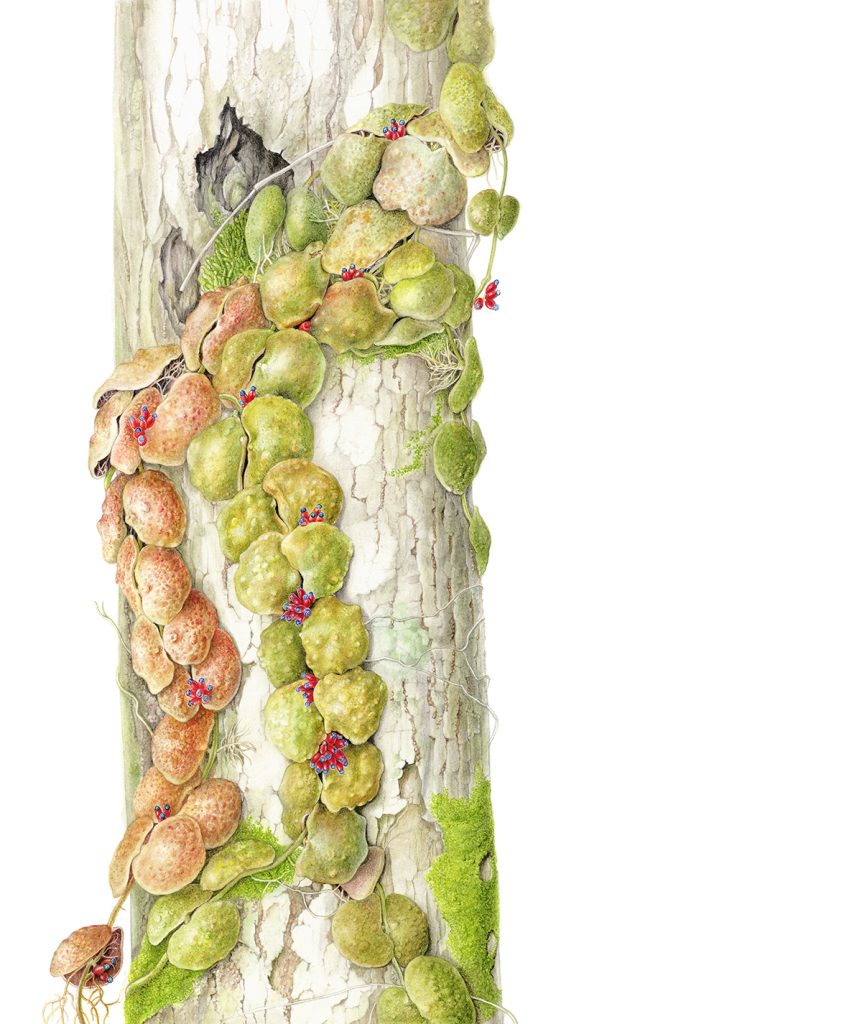
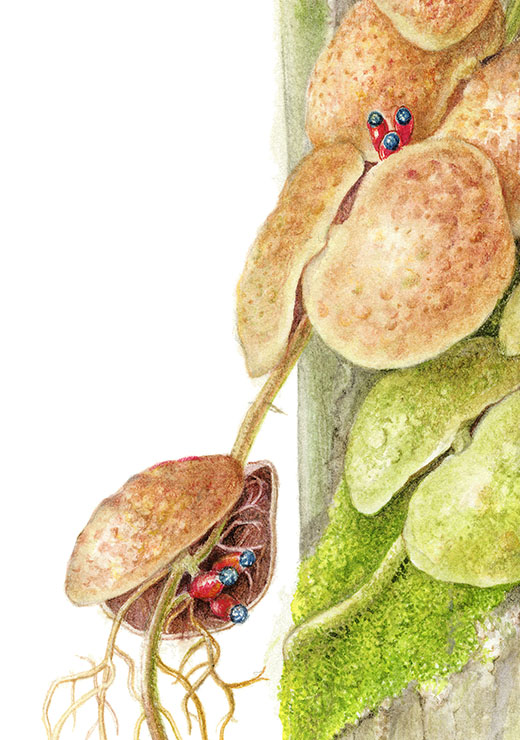
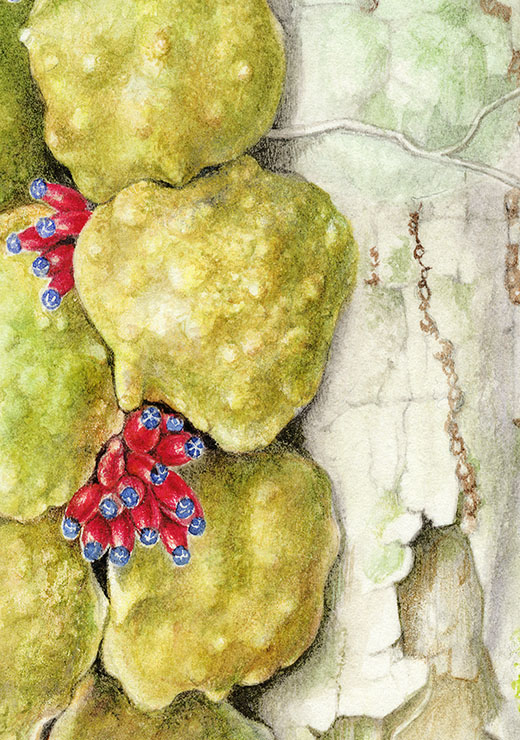
Dischidia
Dischidia cochleataディスキディア コクレアータThere are two main types of symbiotic relationships between ant plants and the ants that live with them. One type is the "predator defense" type, in which the ant plant's workers attack and eliminate external enemies that harm the plant, such as herbivores and vines. It's like hiring an all-inclusive, live-in guard. The other type, called "nutritional symbiosis," is seen in ant plants distributed in environments where nutrients are difficult to obtain, such as epiphytic plants. Dischidia is an example of an ant plant that exhibits nutritional symbiosis. It is a vine that twines around trees in the forest, and its hard leaves grow on organic matter deposited by arboreal ants. The ants reportedly use the leaf tunnels, which are shaded from the sun by the leaves' purple undersides, for their activities, though no detailed research has been conducted.
蟻植物とアリは、共生関係にあるが、大きく分けて2つのタイプがある。1つは「捕食防御型」で、共生するアリの働き手が、植物食の植物やツル植物など、蟻植物に害を与える外敵を攻撃して排除するサービスを提供する、いわば住み込みの食事付きガードマンを雇っているようなもの。もう一つのタイプは「栄養共生」と呼ばれ、着生植物など、定着して栄養を得ることが難しい環境に分布するアリ植物に見られる。ディスキディアはこの栄養共生するアリ植物。つる性植物で森林の高い樹木に巻きつき、対生の葉は固く、樹上性のアリが堆積する有機物で生育、アリは葉の裏が紫色のため強い太陽から守られた葉のトンネルを活動に利用しているそうだが、詳しい研究はされていない。
33.5 x 28.2cm Watercolor on paper 紙に水彩
-

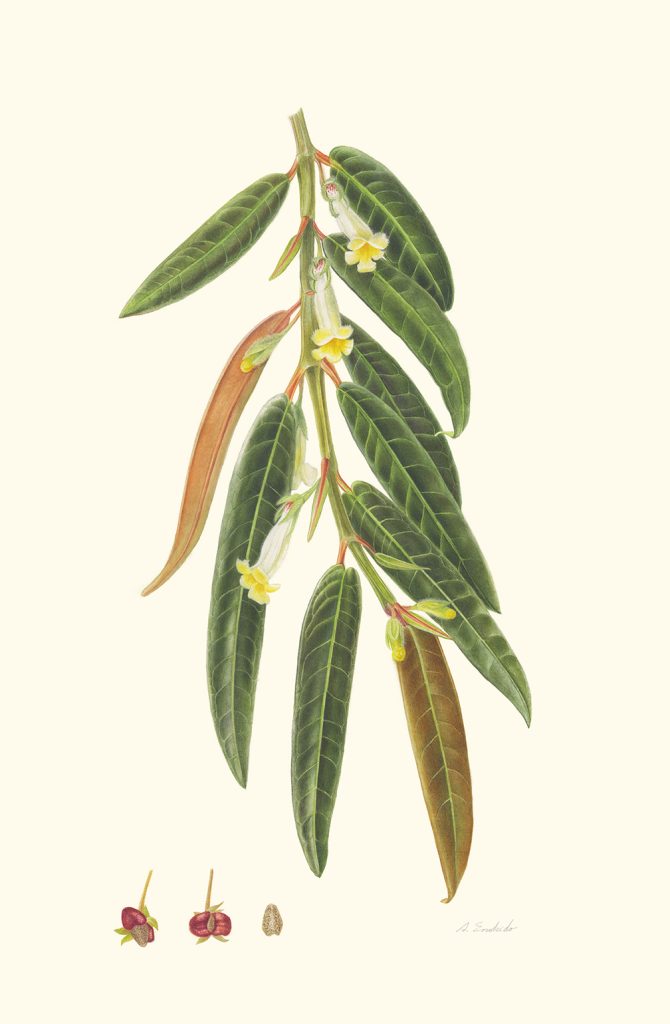
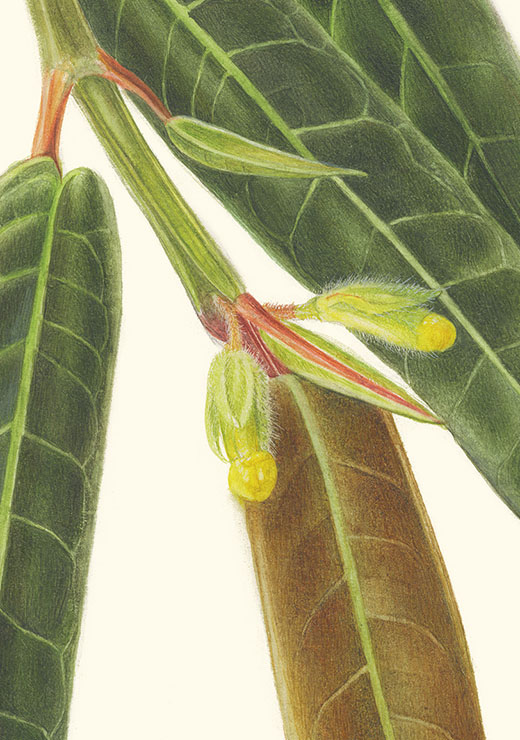
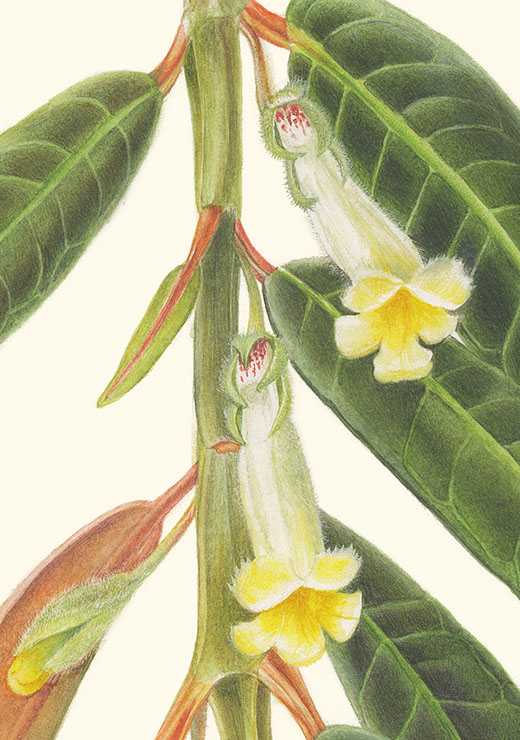
Drymonia
Drymonia decoraドライモニア・デコラDrymonia decora is the most recently recorded of the 24 Drymonia species recognized in Costa Rica.The stems hang down, and the leaves are opposite, leathery, and have a beautiful gradation of color from dark green to reddish-copper, with a long oval shape and rolled edges. The funnel-shaped flowers are yellow. When the fruit is ripe, the seeds can be seen inside the translucent, gelatinous fruit. Painted at Ito Ant Nursery
ドライモニア デコラは、コスタリカで認められている24種のDrymonia のうち、最も最近に記録された種。茎は垂れ下がり、葉は対生で皮革のように硬く、縁が巻き込むドラような長楕円形形で、色も濃緑から赤銅色とグラデーションが美しい。花は漏斗型で黄色。熟すと赤紫色の萼片の中に、半透明のゼラチンのようなものに包まれた果実の中に種子が確認できた。伊藤蟻植物農園にて取材。
45.0 x 30.0cm Watercolor on vellum ヴェラムに水彩
-

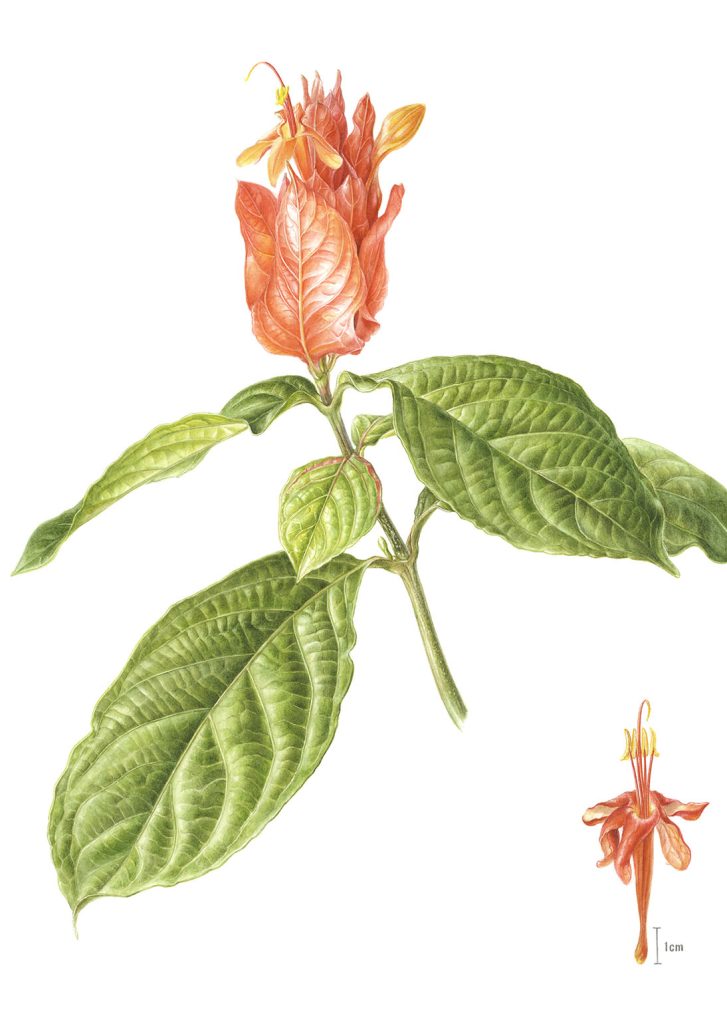
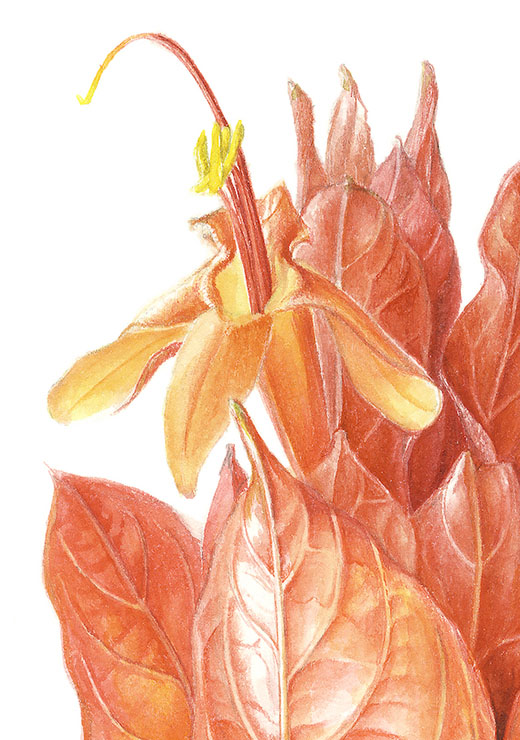
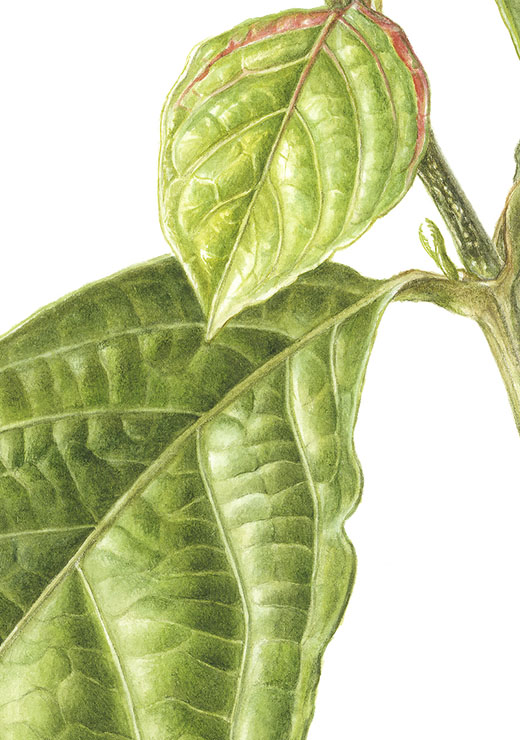
Peruvian Wild Petunia
Ruellia chartaceaペルビアン・ワイルド・ペチュニアThis species is native to the tropical rainforests of South America, specifically Brazil, Colombia, Ecuador, and Peru. It is also known as the red shrimp plant, though it is not related to true petunias, which belong to the nightshade family. The image is used for the plant's nameplate in the National Tropical Botanical Garden (NTBG) in Kauai.
この種は南米の熱帯雨林、ブラジル、コロンビア、エクアドル、ペルーに自生。英名ではレッド・シュリンプ・プラントとも呼ばれる低木で、ナス科のペチュニアとは関係がない。カウアイ島、ナショナル・トロピカル植物園(NTBG)にて制作。このイメージは園内植物のネームプレートに採用されている。
32 x 45cm Watercolor on paper 紙に水彩
-
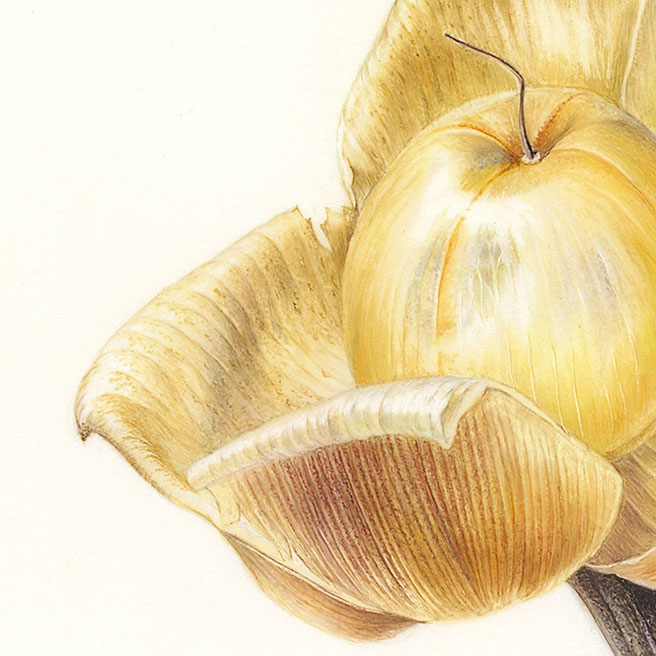
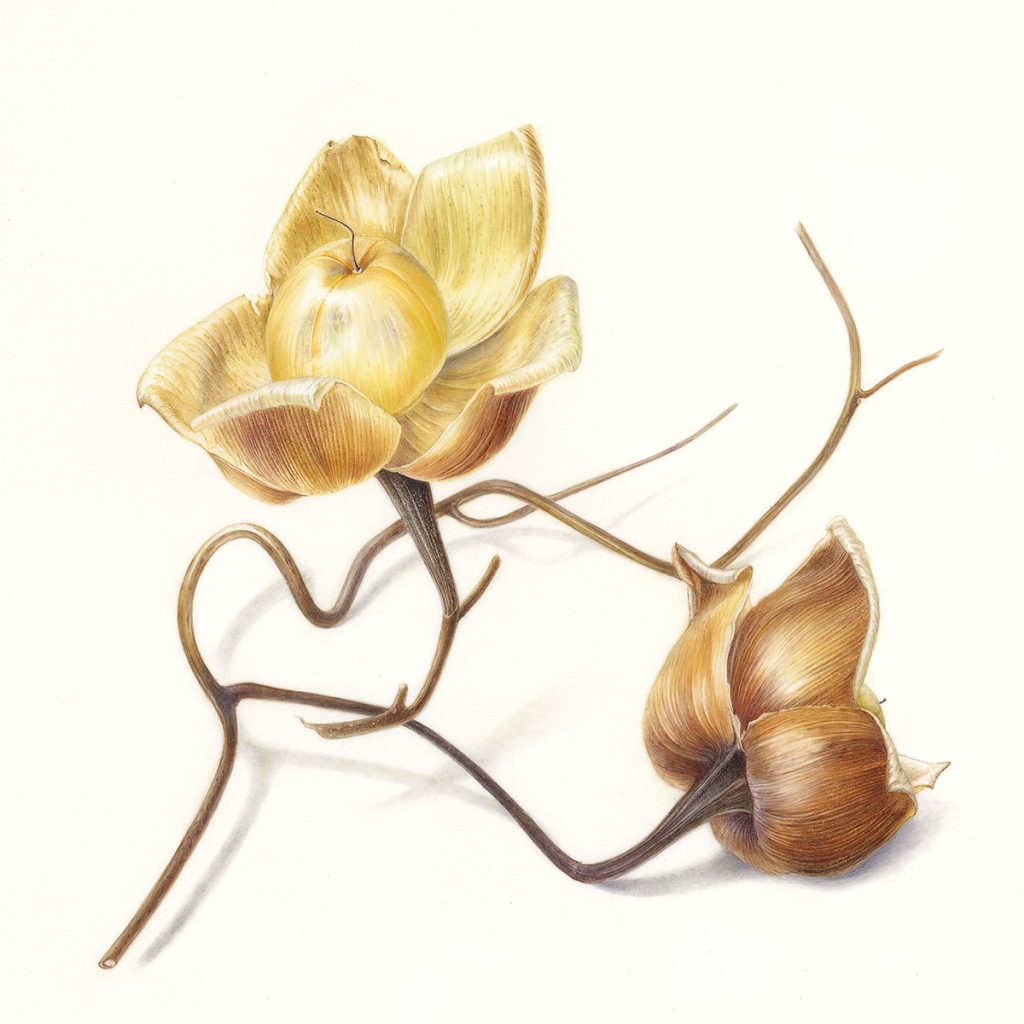
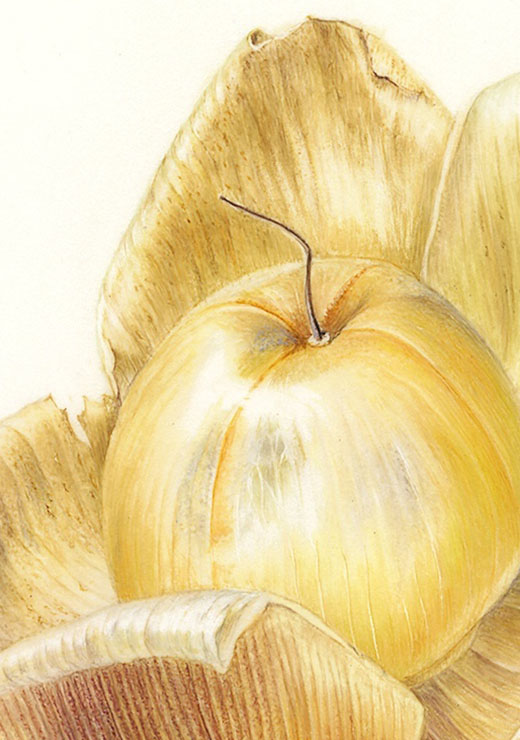
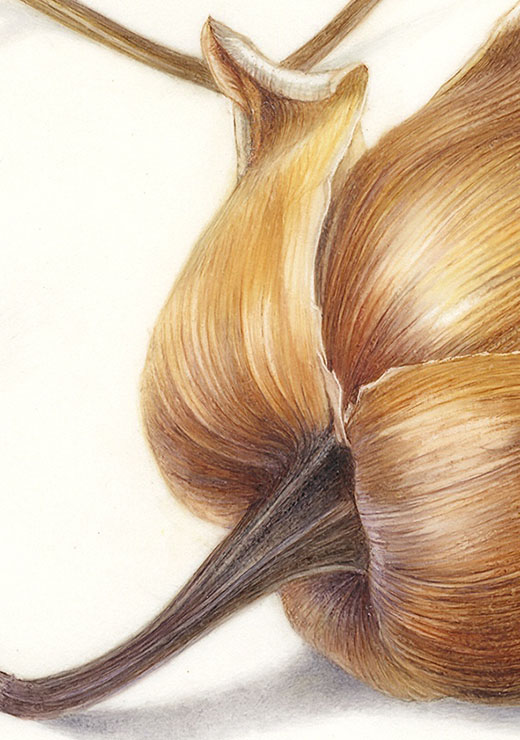
Woodrose
Merremia tuberosaウッドローズWood roses are a species of morning glory native to tropical America, and they produce yellow funnel-shaped flowers. and Their withered fruits resemble dried flowers. They are also highly fertile, and have become naturalized in tropical and subtropical regions around the world.
ウッドローズは熱帯アメリカ原産のヒルガオ科の植物で、黄色い漏斗型の花を咲かせ、枯れた果実はドライフラワーのようになる。繁殖力も強く、世界中の熱帯から亜熱帯に帰化している。
22.5 x 22.5cm Watercolor on paper 紙に水彩
Please refrain from unauthorized reproduction, copying,
or use of the images and artworks on this website on other sites.
当サイトの画像・作品の無断転載、複製、
または他サイトでの使用はご遠慮ください。
